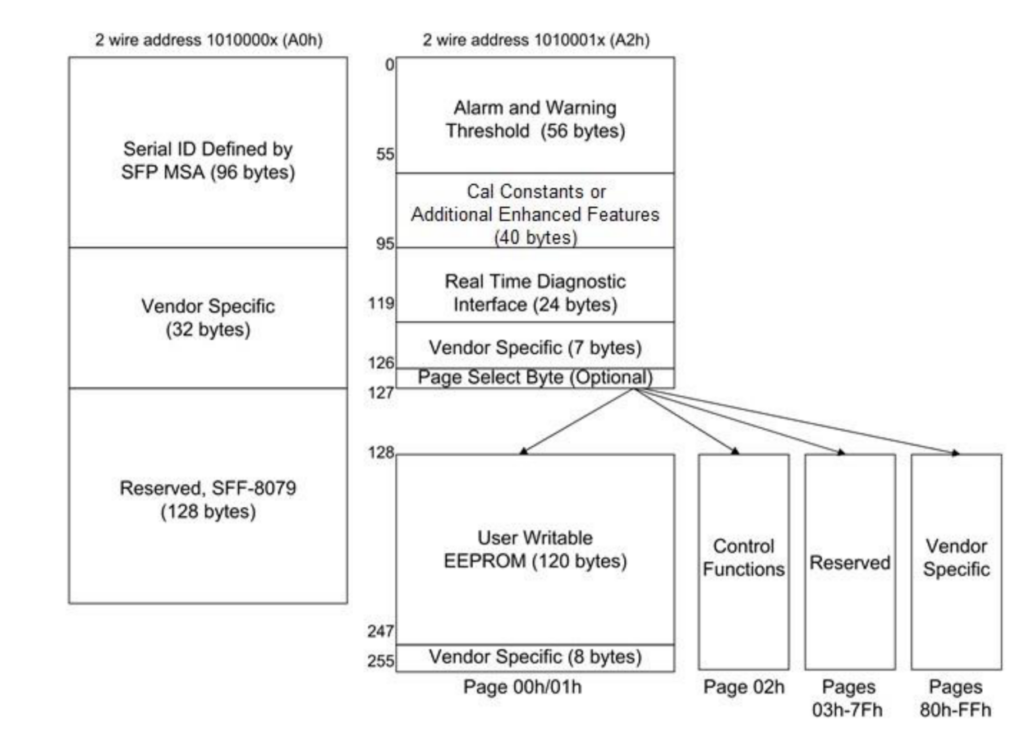DDM Function of Optical Transceiver
DDM : Digital diagnostic monitoring.
DOM : Digital optical monitoring.
DDM and DOM are basically the same thing, but DDM is more commonly used. Both refer to functions for real-time monitoring of various parameters of optical transceiver such as temperature, voltage, and optical power.
What is DDM Function for?
The DDM function can help network administrators discover and solve problems in a timely manner by monitoring optical transceiver parameter information in real time, which can greatly improve the timeliness of troubleshooting and improve the stability and reliability of the network. It also helps optimize the performance of optical networks and provides data support for network planning and optimization.
The working mechanism of DDM
The working mechanism of DDM is to monitor and collect parameter information such as temperature, voltage and optical power in real time through a specific chip (functional circuit) or module inside optical transceiver, and store the latest monitoring information in a register. The purpose of this design is to ensure that network equipment can obtain the latest data at any time to meet management and monitoring needs. When the network device (user) needs it, this data information can be retrieved from the register at any time through the communication protocol (such as I2C), thereby realizing real-time monitoring and management of the optical module status.
MSA Standard
The location of the parameter data monitored by the DDM function in the registers usually follows MSA Standard.
MSA is the abbreviation of Multi-Source Agreement, which means multi-source agreement. The MSA standard defines specifications of the physical dimensions, optical interface, electrical interface, and management interface of optical transceiver, including the location and format of registers used by the DDM function. Such standardized design enables optical transceiver produced by different manufacturers to have a certain degree of compatibility in functions and interfaces, which helps promote the widespread application and interoperability of optical transceiver.

2-wire Interface Fields
What are the MSA protocols involving DDM functions?
SFF-8472: It is a standard for the digital diagnostic monitoring (DDM) function, which specifies the implementation method and parameter definition of the DDM function in optical transceiver. It was developed by the Small Form Factor Committee (SFF) to standardize the design and functionality of the DDM function in optical transceiver to ensure that optical transceiver produced by different manufacturers have a certain degree of uniformity and interoperability in this regard.
SFF-8436: It is an SFP+ MSA standard that specifies the physical size, electrical characteristics, and implementation of DDM functions of SFP+ optical transceiver.
SFF-8636: It is a QSFP+ MSA standard similar to SFF-8436, but applies to QSFP+ optical transceiver and includes specifications for DDM functions.
I2C Communication Protocol
I2C: It is a communication protocol used for DDM data transmission. It specifies the format, timing and communication method of data transmission, so that the DDM function in optical transceiver can effectively exchange data and communicate with network equipment.
The I2C communication protocol (Inter-Integrated Circuit) is a serial communication protocol originally designed for communication between chips. It uses two wires (serial data line SDA and serial clock line SCL) to transmit data. With this protocol, multiple devices can communicate over the same pair of wires, with each device having a unique address. During the communication process, one device can act as the master device to send data, while other devices are in a passive receiving state. This simple and flexible protocol is widely used in various electronic devices.
Although the I2C communication protocol was originally designed for communication between chips, it can also be used for communication between other devices as long as these devices support the I2C protocol. For example, many sensors, memory, and peripheral devices can communicate with the host controller via I2C.
Can we use the serial port to read DDM monitoring information through an I2C to serial or USB cable?
The answer is yes. By using an I2C to serial or USB cable, the DDM monitoring information in optical transceiver can be transmitted to the connected device through the serial port protocol. Such a device can read serial port data and parse the DDM monitoring information therein to monitor and manage the status of the optical module.
Additional Notes
The use of DDM to monitor data is not necessarily limited to network devices. As long as the DDM information in the register can be accessed and obtained, the corresponding parameter information can be parsed. This means that different devices or tools can be used to read and parse DDM monitoring information to monitor and manage the status and performance of optical modules.
Related posts:
- Next-Gen Data Transfer: SFP112/QSFP112/QSFP-DD800/OSFP 800G DAC
- Everything You Need to Know About CWDM Transceivers: From SFP Modules to 80km Optical Fiber Connectivity
- The Ultimate Guide to SGMII SFP Transceivers: Everything You Need to Know About Optical Transceivers and Ethernet Ports
- Unraveling the World of 400ZR: Enhancing DCI Networks with QSFP-DD and DWDM up to 120km.
